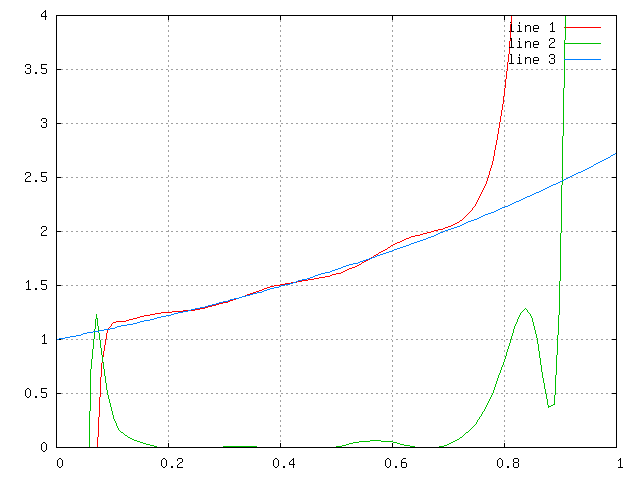Numerical calculation of functional root
Functional root of function g(x) is function f(x), such that:
f(f(x)) = g(x)
General solution of this problem may be obtained via Abel's equation. here I will show a numeric approach, based on tailor series.
In general case, using Tailor series is complicated, but problem becomes much more simple, if g(0)=0. (or, in more general case, if there exists a such that g(a)=a. In this case, substitution g1(x)=g(x+a)-a may be used)
Here is Taylor series for f(x) : f(f(x))=sin(x)
b=[1,0,-1,0,1,0,-1,0];b=[b,b,b];b=[b,b,b]
derivs35
k=f./factorial(1:length(f));
1 1
3 -8.33333333333333e-02
5 -6.25000000000000e-03
7 -1.31448412698413e-03
9 -3.20870535714286e-04
11 -7.25830038981081e-05
13 -9.30961590412545e-06
15 3.55278377180633e-06
17 3.61718730214484e-06
19 1.67771221103390e-06
21 3.74835625939595e-07
23 -9.90538181643828e-08
25 -1.19505318825601e-07
27 -2.41736426371567e-08
29 2.70861781928743e-08
31 1.79479210513537e-08
33 -7.50080741478029e-09
It gives error < 10-4 for |x| < 1.4 and < 10-16 for |x| < 0.6. For x=pi/2 error is about 1e-2..1e-3.
Increasing number of elements does not increases convergence at 1.6 much.
More interesting thing is half-exponent: f(f(x))=ex. Exponent does not intersects line y=x, so Taylor approach cannot be used. But if we consider complex x and y, intersection exists (furthermore, there are infinite number of intersections).
These points ma be found using Lambert's W function:
a0=-lambertw(-1)
ans = 0.318131505204764 - 1.337235701430689i
Now let us shift to the point a0 and calculate Taylor series at this point:
g(x) = ex + a0 - a0
All derivatives of g(x) at 0 are equal to ea0. therefore let's use algorhytm
b=ones(1,35)*a0;
derivs35
k=f./factorial(1:length(f));
plot(abs(k(1:end-1)./k(2:end))) %from this plot we can see convergence radius that is about 1.3, which is close to complex part of a0.
axis([0,35,0,2.5])
Therefore, this series can not be used for calculation of half-exponent at real axis.
Newertheless, let's try
x=linspace(0,1,100);y=polyval([fliplr(k),0],x-a0)+a0;yy=polyval([fliplr(k),0],y-a0)+a0;
plot(x,real(yy),x,imag(yy),x,exp(x))
axis([0,1,-0.5,2])
 This graph shows that convergence is really bad, but at interval [0.2..0.7] results are adequate.
Looks like f(x) is significantly non-real for real arguments, though it may be result of bad convergence.
Besides, equation exp(x)=x has other solutions. Maybe, they give better series? Let us try.
a0=-lambertw(1,-1)
a0 = 2.06227772959828 - 7.58863117847251i
Radius is about
b=ones(1,35)*a0;
derivs35
k=f./factorial(1:length(f));
Radius is about 8.2, but |a0| is about 7.8. Alas, convergense still bad.
This graph shows that convergence is really bad, but at interval [0.2..0.7] results are adequate.
Looks like f(x) is significantly non-real for real arguments, though it may be result of bad convergence.
Besides, equation exp(x)=x has other solutions. Maybe, they give better series? Let us try.
a0=-lambertw(1,-1)
a0 = 2.06227772959828 - 7.58863117847251i
Radius is about
b=ones(1,35)*a0;
derivs35
k=f./factorial(1:length(f));
Radius is about 8.2, but |a0| is about 7.8. Alas, convergense still bad.
Files
Python script for generating the derivs35.m file: derivs.py.
Usage: python derivs.py > derivs35.m
To change maximal order, find line N=35 in script and change it. Complexity grows almos exponentially, so more than 45 is probably impossible to calculate.
Generated script itself (bziped): derivs35.m.bz2.derivs2.m.bz2derivs10.m.bz2
Usage: create aray named b, containing derivatives of g(x) at zero. For example, for sin(x):
b=[1,0,-1,0];b=[b,b,b,b,b];
Then run derivs35. it will create array f, containing values of derivative of f(x) at zero. To get Taylor series of f(x), divide elements of f by n!:
k=f./factorial(1:length(f));
To calculate value of function use polyval:
y=polyval([fliplr(k),0],x);
Сайт управляется системой
uCoz This graph shows that convergence is really bad, but at interval [0.2..0.7] results are adequate.
Looks like f(x) is significantly non-real for real arguments, though it may be result of bad convergence.
Besides, equation exp(x)=x has other solutions. Maybe, they give better series? Let us try.
a0=-lambertw(1,-1)
a0 = 2.06227772959828 - 7.58863117847251i
Radius is about
b=ones(1,35)*a0;
derivs35
k=f./factorial(1:length(f));
Radius is about 8.2, but |a0| is about 7.8. Alas, convergense still bad.
This graph shows that convergence is really bad, but at interval [0.2..0.7] results are adequate.
Looks like f(x) is significantly non-real for real arguments, though it may be result of bad convergence.
Besides, equation exp(x)=x has other solutions. Maybe, they give better series? Let us try.
a0=-lambertw(1,-1)
a0 = 2.06227772959828 - 7.58863117847251i
Radius is about
b=ones(1,35)*a0;
derivs35
k=f./factorial(1:length(f));
Radius is about 8.2, but |a0| is about 7.8. Alas, convergense still bad.